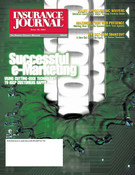I get asked a number of questions about websites, their development and usefulness. But invariably, the questions that pop up most often have to do with getting visitors to the site and getting them to interact with the site, whether for purchase, for quotes or for information.
And they are fair questions. There is nothing worse than building a site that only generates “trickle traffic” or is a “one-hit wonder”—a person jumps onto a page and then promptly leaves the site. So to prevent that from happening and to grow a larger online base, let’s “keep” a few things in mind.
Keep it simple
First and foremost, get a domain name that’s easy to remember. Even if AOL gives you 10 MB of web space or Freeservers.com offers free websites with a number of domain names, you need to make sure that your site name makes sense. That means you need a URL that says who you are or what you do, such as www.youragencynamehere.com or www.westcoastboatinsurance.com. Domain names are cheap to reserve these days (I’ve seen them as low as $9.95 per year), and a good one sure beats trying to recite a string of dots and slashes to get to a freebie page.
Second, make it simple to find. Put the URL on everything associated with your agency. Business cards, letterhead, faxes, e-mails—you name it, put the www address on it. This way potential customers who are trying to find out more about you can find the URL quickly without having to use a search engine.
Speaking of search engines, that brings me to the third point. Register the site and pages with every search engine you can think of. Places like SiteOwner.com can help you register your site with a number of search engines simultaneously, or you can visit the major engines and type in your website address where it says “Add your site.” Also, check with the companies you write for—if they have an agent locator feature on their site, then you should submit your website address.
Keep it integrated
Equally as important is the idea that the website is an extension of the agency. This means that the image, the identity and the perceptions that make up the agency need to be evident on the website. One of the biggest failures has been a lack of connection between the website and the agency.
Building a brand is a key component for marketing across media. For that to happen, you’ve got to integrate the marketing; integrate the communication across the media. On a rudimentary level this is what is happening when a person sees the site address on your business card, but it is and needs to be so much more than that.
First and foremost, make sure that your website fits in with the rest of your collateral material. Using the previous example, if I type in the site address from your business card, the site needs to look similar to the business card in color and composition—its “look and feel.”
Furthermore, you are also (whether you know it or not) marketing your site as a common office tool between you and your customers and prospects. Therefore, the site must be also integrated into your workflow. The same way people are directed to the fax machine for information from you, they can be directed to the website.
Or, instead of explaining the whole shebang about a product in an e-mail, summarize it and add a link to the site for more information. You can do a whole lot more on a web page to try and sell than you can in the text of an e-mail. Plus, click-through in e-mail can build up site traffic—and captive traffic at that.
A number of agents I know are now offering a “customer service area” or centralized area where they provide PDF forms of all different types for their customers. These can be printed out by the end-user, and it frees up the office phone/fax line. The PDFs are easy to create, are screen fillable and then sent/faxed back by the customer.
Integration from an office standpoint really begins with the fundamental change of thinking that says, “We will use the web first as our means of disseminating information.”
Keep it fresh
If you’ve noticed, I haven’t said anything about adding automatic quotes, raters, taking credit card payments over the web, or secure servers for e-commerce. Again, the website’s functionality is no different than the equipment you buy for your office.
The same way you keep your office up to date with information, infrastructure and equipment is the same way you should keep up your website. A site that’s up-to-date, easy to find, looks like what the visitor expects, and offers the functionality the visitor expects, is a site that has been marketed successfully and is successful.
Was this article valuable?
Here are more articles you may enjoy.


 Brookfield Targets Global Dominance in P/C Insurance Coverage
Brookfield Targets Global Dominance in P/C Insurance Coverage  Hartford: 10-Year Analysis Shows Shifts in Common, Expensive Small-Business Claims
Hartford: 10-Year Analysis Shows Shifts in Common, Expensive Small-Business Claims  Viewpoint: Agentic AI Is Coming to Insurance Industry – Much Faster Than You Think
Viewpoint: Agentic AI Is Coming to Insurance Industry – Much Faster Than You Think  State Farm Sued Over Policies Backed by Distressed Insurer PHL
State Farm Sued Over Policies Backed by Distressed Insurer PHL 


